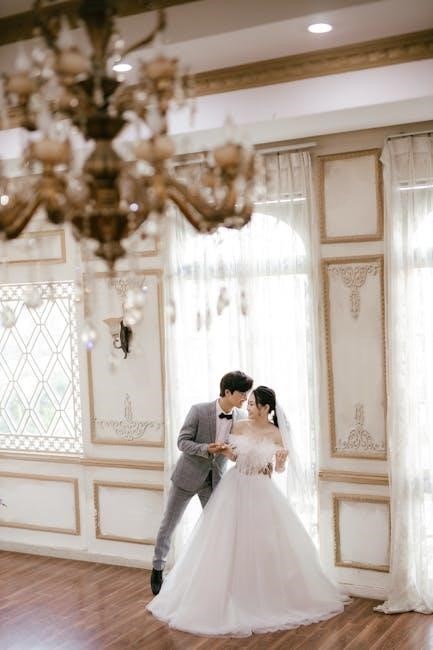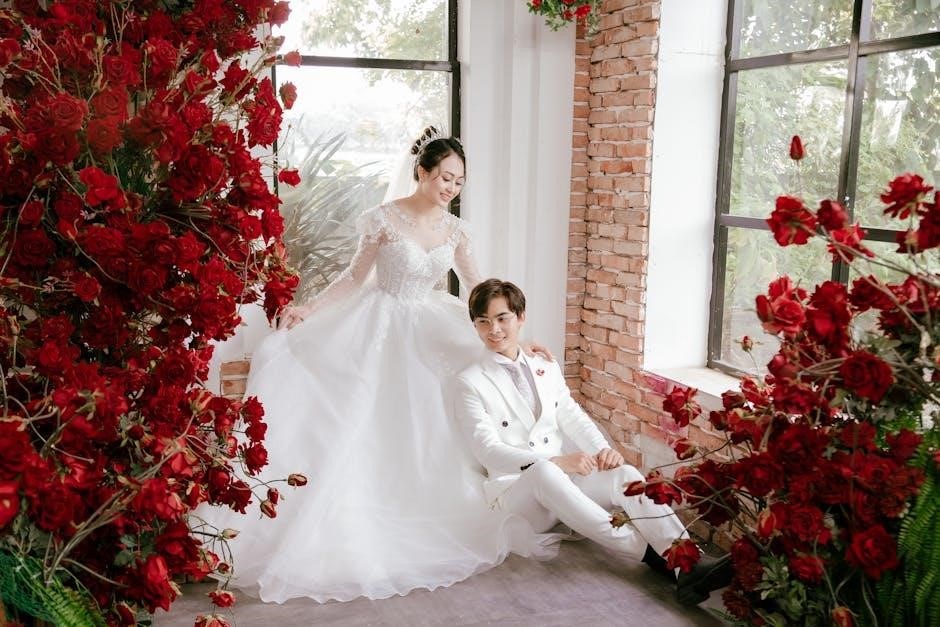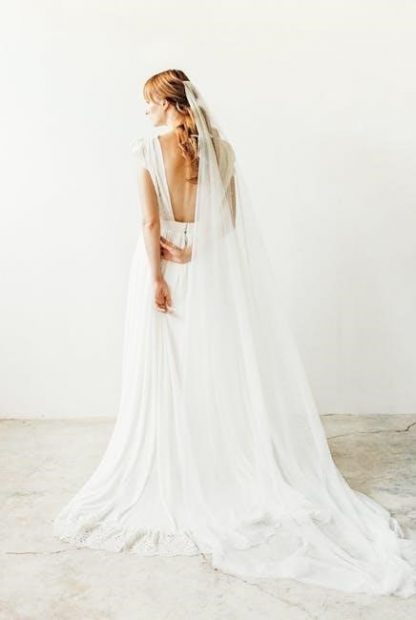A wedding veil is a timeless bridal accessory, symbolizing romance and tradition. Its length plays a crucial role in enhancing the bride’s overall look and wedding theme, making it a key element in bridal styling.
1.1 Importance of Veil Lengths in Wedding Fashion
Veil lengths are a crucial element in wedding fashion, as they enhance the bride’s overall appearance and complement the wedding dress. The right length can create a balanced look, drawing attention to the bride’s face or accentuating the dress’s details. Additionally, the veil length should harmonize with the wedding venue and theme. Whether short and sleek or long and dramatic, the veil length is a personal choice that reflects the bride’s style and adds a perfect touch of elegance to her wedding day look.
1.2 Brief History of Wedding Veils
The wedding veil has a rich history dating back to ancient Roman and Greek customs, symbolizing modesty, purity, and protection. Initially, veils were used to ward off evil spirits and represent the bride’s submission to her husband. During the Victorian era, Queen Victoria popularized the white wedding veil, making it a staple in bridal attire. Over time, the veil evolved from a symbol of modesty to a fashion statement, with its length and style reflecting the bride’s personal taste and cultural traditions, becoming an enduring element of wedding celebrations.

Popular Wedding Veil Lengths
Wedding veils come in various lengths, each offering a unique appeal. From the short birdcage to the dramatic cathedral, there’s a style to suit every bride’s vision and dress.
2.1 Birdcage Veil
The birdcage veil is a bold, vintage-inspired choice, typically covering the face or reaching just below the chin. Its shorter length adds a retro charm, perfect for brides seeking a unique, sophisticated look. Ideal for highlighting facial features, it pairs well with sleek hairstyles and minimalist gowns. Despite its short length, it exudes elegance, making it a popular choice for modern and bohemian weddings alike. This veil style is great for those wanting a statement accessory without overwhelming the overall bridal ensemble.
2.2 Shoulder Veil
The shoulder veil is a popular choice, typically measuring 20 inches in length, and gracefully drapes to the bride’s shoulder. It strikes a perfect balance between subtlety and elegance, complementing most wedding dress styles without overwhelming the overall look. This veil is ideal for brides who want a classic yet understated appearance. Its mid-length design ensures it remains in place throughout the ceremony and reception, while its simplicity allows the wedding dress to take center stage. It’s versatile, suitable for both formal and semi-formal weddings, and pairs well with a variety of themes and venues.
2.3 Elbow Veil
The elbow veil measures approximately 25 inches in length, reaching just below the elbow. It’s a classic choice that offers a balanced look, pairing well with both simple and embellished wedding dresses. This veil is versatile, complementing various wedding themes and styles while adding a touch of elegance without overwhelming the bride’s overall appearance. Its mid-length design ensures it moves gracefully with the bride, making it ideal for ceremonies and receptions. The elbow veil is a timeless option that enhances the bridal look while maintaining a sense of sophistication and poise.
2.4 Fingertip Veil
The fingertip veil extends to approximately 43 inches, grazing the bride’s fingertips for a dramatic yet romantic appearance. This length is ideal for brides seeking a statement piece that complements their wedding dress without overpowering it. It flows gracefully, creating a stunning visual effect during the ceremony and photos. The fingertip veil is a popular choice for its ability to enhance the bride’s silhouette while maintaining an elegant, ethereal look. Its versatility makes it suitable for both traditional and modern wedding themes, ensuring a memorable and captivating bridal presence.
2.5 Waltz or Ballerina Veil
The Waltz or Ballerina veil typically measures around 54 inches, reaching just below the hips or mid-calf; Its flowing design creates a soft, romantic silhouette, perfect for brides who want a dramatic yet understated look. This length is ideal for showcasing intricate wedding dress details while allowing ease of movement, making it a popular choice for dancing; The Waltz veil strikes a balance between elegance and practicality, complementing both classic and contemporary wedding styles effortlessly. Its gentle drape adds a touch of sophistication to the overall bridal ensemble, ensuring a memorable appearance.
2.6 Floor-Length Veil
The Floor-Length veil extends to the hem of the wedding dress, typically measuring around 72 inches. This style creates a seamless, cohesive look with the gown, ideal for brides seeking a classic and polished appearance. It elegantly drapes to the floor, complementing dresses without a train while adding a touch of sophistication. The Floor-Length veil is versatile, suiting both traditional and modern wedding themes, and is particularly flattering for outdoor ceremonies or formal events. Its streamlined design ensures it enhances the bride’s overall elegance without overwhelming her ensemble.
2;7 Chapel Veil
The Chapel Veil is a popular choice among brides, measuring approximately 90 inches in length. It extends just beyond the train of the wedding dress, creating a dramatic yet balanced look. This veil is ideal for formal weddings and adds a touch of elegance without overwhelming the bride’s ensemble. Often featuring a single or double layer, it may include a blusher for added charm. The Chapel Veil complements various wedding themes and dress styles, making it a versatile option for brides seeking a classic, sophisticated appearance on their special day.
2.8 Cathedral Veil
The Cathedral Veil is the longest and most dramatic option, typically measuring 108-120 inches. It extends far beyond the train of the wedding dress, creating a grand, elegant appearance. This veil is perfect for formal or traditional weddings, as it adds a luxurious and sophisticated touch. Often paired with intricate details like lace or embroidery, the Cathedral Veil makes a stunning statement. Its length requires careful consideration to ensure it complements the wedding dress and venue, making it a popular choice for brides seeking a classic, fairytale-inspired look.

How to Choose the Right Veil Length
Selecting the perfect veil length involves considering your wedding dress style, venue, body proportions, and personal preference. It should enhance your look while ensuring comfort and elegance.
3.1 Considering Your Wedding Dress Style
Your wedding dress style is a key factor in choosing the right veil length. For mermaid or trumpet dresses, a shorter veil like a fingertip or elbow length complements the silhouette. Ball gowns look stunning with longer veils, such as chapel or cathedral lengths, to mirror the grandeur. Sheath or column dresses pair well with shorter veils like shoulder or elbow lengths to avoid overwhelming the streamlined look. Ensure the veil enhances your dress without competing with its details or fabric.

3.2 Venue and Theme Compatibility
The venue and theme of your wedding significantly influence the choice of veil length. For indoor ceremonies, shorter veils like shoulder or elbow lengths are practical and elegant. Outdoor or garden weddings often pair beautifully with longer, flowing veils such as fingertip or chapel lengths. A formal church wedding might call for a dramatic cathedral veil, while a rustic or vintage theme could suit a shorter, lace-trimmed birdcage or flyaway veil. Ensure the veil complements the setting and enhances the overall aesthetic of your celebration.
3.3 Body Type and Proportions
Your body type and proportions play a significant role in selecting the perfect veil length. Petite brides often look stunning in shorter veils, such as shoulder or elbow lengths, which avoid overwhelming their frame. Taller brides can elegantly carry longer veils like cathedral or chapel lengths. Consider your silhouette—curvier figures may find balance with a flowing veil, while slimmer frames might prefer a more tailored look. Ensure the veil complements your natural proportions, enhancing your beauty without overpowering it.
3.4 Personal Preference and Comfort
Personal preference and comfort are vital when choosing a wedding veil length. Some brides adore the dramatic flair of a long cathedral veil, while others prefer the simplicity of a short birdcage or shoulder veil. Consider how the veil feels throughout the day—longer veils can be heavy or restrictive. If comfort is a priority, opt for a lightweight, detachable style or a shorter length that allows ease of movement. Ultimately, your veil should reflect your personality and make you feel confident and comfortable on your special day.
Veil Styling Tips
Veil styling enhances your bridal look by adding elegance and personality. Coordinate your veil length with your dress, add embellishments for sparkle, and secure it for a flawless finish.
4.1 Coordinating Veil Length with Your Wedding Dress
Coordinating your veil length with your wedding dress ensures a harmonious bridal look. For a trainless gown, a floor-length veil adds elegance. If your dress has a train, opt for a chapel or cathedral veil to create a stunning flow. Shorter veils, like elbow or shoulder lengths, complement simpler or form-fitting dresses, while longer veils enhance dramatic or traditional gowns. Matching the veil’s fabric and embellishments to your dress ensures a cohesive style, making your overall appearance truly unforgettable.
4.2 Adding Embellishments or Accessories
Embellishments and accessories can elevate your wedding veil, adding a personal touch. Consider lace trim, beaded edges, or delicate crystals for a refined look. Matching your veil’s details to your dress, such as embroidery or sequins, creates a cohesive style. A blusher layer or floral accents can add romance. Accessories like headbands or combs not only secure the veil but also enhance its beauty. These additions ensure your veil complements your overall bridal look, making it a standout accessory on your special day.
4.3 Securing the Veil for the Ceremony and Reception
Securing your wedding veil properly ensures it stays in place throughout the ceremony and reception. A comb or hairpin is the most common method, gently attaching the veil to your hairstyle. For added stability, use bobby pins to anchor the comb or pins to your hair. If wearing a blusher, it can be lifted by your partner or attached separately. Choose a secure yet comfortable method to enjoy your day without worrying about adjustments. Properly securing your veil ensures it enhances your look seamlessly.
Expert Advice for Veil Length Selection
Experts recommend selecting a veil length that balances your body proportions and complements your wedding dress, ensuring a harmonious and polished bridal look.
5.1 Measuring for the Perfect Fit
Measuring for your wedding veil ensures a flawless fit. Start by measuring from the top of your head to your desired endpoint, such as your shoulders, elbows, or floor. Use a flexible tape measure or a piece of string to gauge the length accurately. Consider the style of your dress and how the veil will drape. For longer veils, add 20-30 cm to the train length of your gown. Always try the veil on with your dress to ensure proper placement and flow, making adjustments as needed for a personalized fit.
5.2 Maintenance and Care of Your Wedding Veil
To preserve your wedding veil, handle it gently to avoid creases or damage. Store it in a sturdy, breathable box away from direct sunlight. For cleaning, opt for professional services, as veils are often made of delicate materials. Avoid steaming or ironing yourself, as this can harm the fabric or embellishments. Before the wedding, ensure the veil is pressed and ready. On your big day, have a trusted person assist with placement to prevent accidental tears or misalignment. Proper care ensures your veil remains pristine for years.
